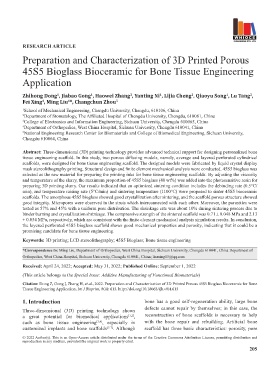Page 213 - IJB-8-4
P. 213
RESEARCH ARTICLE
Preparation and Characterization of 3D Printed Porous
45S5 Bioglass Bioceramic for Bone Tissue Engineering
Application
Zhihong Dong , Jiabao Gong , Haowei Zhang , Yanting Ni , Lijia Cheng , Qiaoyu Song , Lu Tang ,
2
1
1
1
2
3
1
Fei Xing , Ming Liu *, Changchun Zhou 5
4
4
1 School of Mechanical Engineering, Chengdu University, Chengdu, 610106, China
2 Department of Stomatology, The Affiliated Hospital of Chengdu University, Chengdu, 610081, China
3 College of Electronics and Information Engineering, Sichuan University, Chengdu 610065, China
4 Department of Orthopedics, West China Hospital, Sichuan University, Chengdu 610041, China
5 National Engineering Research Center for Biomaterials and College of Biomedical Engineering, Sichuan University,
Chengdu 610064, China
Abstract: Three-dimensional (3D) printing technology provides advanced technical support for designing personalized bone
tissue engineering scaffold. In this study, two porous diffusing models, namely, average and layered perforated cylindrical
scaffolds, were designed for bone tissue engineering scaffold. The designed models were fabricated by liquid crystal display
mask stereolithography printing. Structural design and finite element mechanical analysis were conducted. 45S5 bioglass was
selected as the raw material for preparing the printing inks for bone tissue engineering scaffolds. By adjusting the viscosity
and temperature of the slurry, the maximum proportion of 45S5 bioglass (40 wt%) was added into the photosensitive resin for
preparing 3D printing slurry. Our results indicated that an optimized sintering condition includes the debinding rate (0.5°C/
min), and temperature raising rate (5°C/min) and sintering temperature (1100°C) were proposed to sinter 45S5 bioceramic
scaffolds. The amorphous 45S5 bioglass showed good crystallization after sintering, and the scaffold porous structure showed
good integrity. Micropores were observed in the struts which interconnected with each other. Moreover, the porosities were
tested as 57% and 45% with a uniform pore distribution. The shrinkage rate was about 10% during sintering process due to
binder burning and crystallization shrinkage. The compressive strength of the sintered scaffold was 0.71 ± 0.048 MPa and 2.13
± 0.054 MPa, respectively, which are consistent with the finite element mechanical analysis simulation results. In conclusion,
the layered perforated 45S5 bioglass scaffold shows good mechanical properties and porosity, indicating that it could be a
promising candidate for bone tissue engineering.
Keywords: 3D printing; LCD stereolithography; 45S5 Bioglass; Bone tissue engineering
*Correspondence to: Ming Liu, Department of Orthopedics, West China Hospital, Sichuan University, Chengdu 610041, China Department of
Orthopedics, West China Hospital, Sichuan University, Chengdu 610041, China; liuming15@qq.com
Received: April 24, 2022; Accepted: May 31, 2022; Published Online: September 1, 2022
(This article belongs to the Special Issue: Additive Manufacturing of Functional Biomaterials)
Citation: Dong Z, Gong J, Zhang H, et al., 2022. Preparation and Characterization of 3D Printed Porous 45S5 Bioglass Bioceramic for Bone
Tissue Engineering Application, Int J Bioprint, 8(4): 613. http://doi.org/10.18063/ijb.v8i4.613
1. Introduction bone has a good self-regeneration ability, large bone
Three-dimensional (3D) printing technology shows defects cannot repair by themselves; in this case, the
a great potential for biomedical applications [1,2] , reconstruction of bone scaffolds is necessary to help
such as bone tissue engineering [3,4] , especially in with the bone repair and rebuilding. Artificial bone
customized implants and bone scaffolds [5-7] . Although scaffold has three basic characteristics: porosity, pore
© 2022 Author(s). This is an Open-Access article distributed under the terms of the Creative Commons Attribution License, permitting distribution and
reproduction in any medium, provided the original work is properly cited.
205

